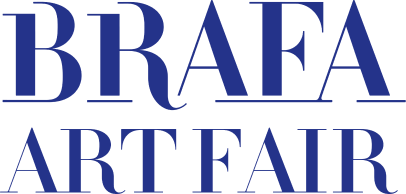DÉTAILS DE L'IMAGE

Galerie Kevorkian
Earthenware rhyton
Iran, late Parthian- early Sasanian, 2nd-3rd century AD
Total height: 39 cm
Head height: 7.5 cm
Provenance : Private collection, Israël, since 1982; Hôtel Drouot, Paris, 1 June 2007
Rython with molded, modeled and turned decoration under a turquoise glaze, in the form of a curved conical amphora, the tubular neck flanked by two twisted handles ending in animal heads on each side of the flared lip, the curved base tapering into a caprine head with long ribbed horns and a pouring hole at the mouth.
The body is decorated with a large medallion enclosing a figure reclining on a dining couch (gr. klinê /
lat. Lectus), in the semi-recumbent position of a banqueter. Below, a large female head, with pointed
protruding nose and chin, framed by an abundant puffed hairdo and a beaded necklace hanging from
a diadem consisting in a row of wheat stalks above a band of various motifs.
Iridescence.
A rhyton, from the Greek word “to flow” is a horn-shaped drinking vessel, usually ending into an animal head or
foreparts. It was used in a wide range of religious or secular ceremonies, as well as in rituals of investiture or transfer of the royal power. This rhyton is one of the most richly decorated and best preserved examples of a small group of late Parthian - early Sasanian glazed pottery vessels with female heads and animal-shaped spouts, used as wine pourers (rhyta) and made in several parts and techniques.
Vessels of this type are rare, particularly those which are semi-complete or, as in our example, nearly complete.
The complexity and the multiplicity of their techniques, involving manufacturing in several parts, turning, molding, modeling and glazing, suggest that they probably imitated or were skeuomorphs of a type of sheet-metal vessel, no example of which has survived or been found yet. Our rhyton displays a mixture of Hellenistic-Roman influence, well attested in Parthian and Sassanian art, through the representation of the banqueting figure reclining on a couch and of Iranian motifs such as the female head with the ‘melon’ hairstyle.
Identification of these figures is uncertain, but the strong similarities presented by the features of our rhyton female head and those on the head of a rhyton kept in the Metropolitan Museum of Art (Metropolitan Museum of New York, acc. n° 2001.178) suggest that it might be identified as that of the goddess Inanna (Ishtar), daughter of the Moon god (Sîn / Nanna) and sister of the Sun god (Utu / Shamash). Even though this Nature and astral deity is referred to in Mesopotamian sources, it may have been of Iranian origin. It has been depicted in Parthian and Kushan art and widely worshipped from Mesopotamia to Central Asia.
Related ceramic rhyta exist in the Louvre Museum (AO 31560), the British Museum (acc. no. BM.37452), the
Victoria & Albert Museum, the Metropolitan Museum of Art (acc. no. 2001.178) and the Cincinnati Art Museum (acc. n° 1952.244)



 TÉLÉCHARGER L'IMAGE
TÉLÉCHARGER L'IMAGE